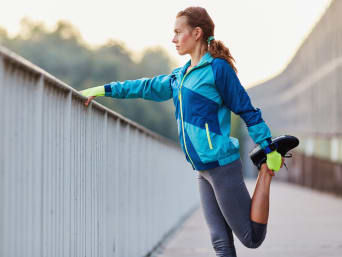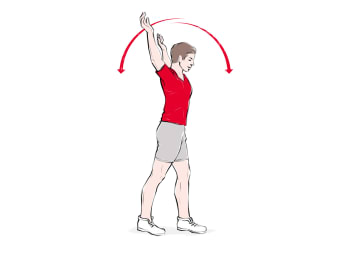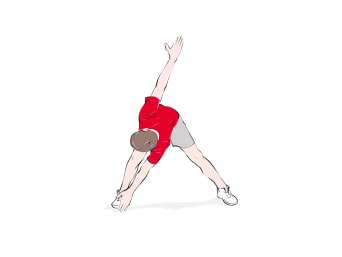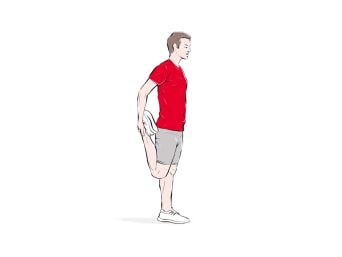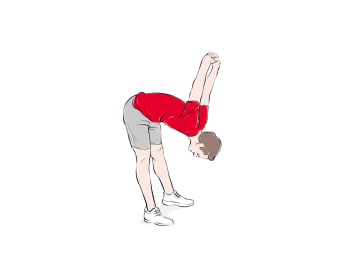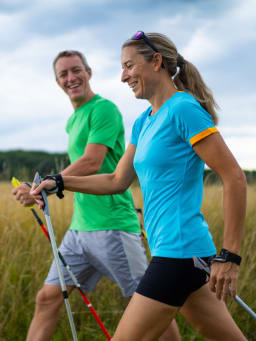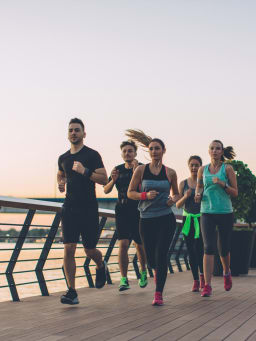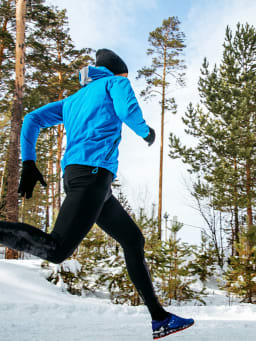Warm-up & cool-down exercises for runners
Running is a great way to keep fit. When you first run you will most probably want to know how far and fast you can run. You should always warm-up before going on a run in order to avoid any injuries. In the long term warm-up and cool-down exercises at the end of your run will help you to reach your training goals. In this article we will show you which warm-up exercises you can do and explain why stretching after running is also an important part of your training. We also give you some tips on what you can do to prevent sore muscles.
Why is it important to warm-up?
With a well-balanced warm-up routine, you can reduce the risk of injuries and get the most out of your training sessions. A warm-up routine should be an integral part of your regular training. Through a dynamic warm-up with various warm-up exercises, you will gently prepare your body for more intense exercises. Once you have warmed up you can get started.
A proper warm-up has many advantages for you and your body:
Increase in heart rate: your metabolism is stimulated, and blood circulation increases.
Warmer muscles: this makes them more resilient, and you can perform better.
Synovial fluid forms in the joints: movement becomes smoother and easier on the joints.
Mentally prepare yourself for your training: you become more focused on the run.
Warm-up exercises should prepare your circulation and muscles for the upcoming training session. It is important to correctly warm-up so that your muscles loosen up, and your heart rate gradually increases. The warm-up exercises should not include any of your training exercises such as strength training or speed work.
You should also make sure that your warm-up matches your training goals. For a normal 20 to 30-minute jog, about a ten-to-fifteen-minute warm-up is enough. However, if you want to run longer distances, practice fast sprints, or try new exercises, you should warm up more thoroughly beforehand. This will prepare your muscles for the harder workout and prevent any injuries.

To make your warm-up more effective, wear a few more layers of clothing. You can remove them when starting your work out and put them back on just before you finish with your cool-down exercises. This is a good way to protect yourself from catching a cold, especially when running in autumn and winter.
Warm-up exercises
Almost all the body is used when running and jogging. It is a good idea to loosen up all muscle groups during your warm-up. Listen to your body when warming up and choose suitable exercises. Not all warm-up exercises or stretches have the same effect on different athletes. Therefore, pay attention to which exercises are good for youand help you feel ready.
Phase 1: Gentle jogging
Duration: 5 to 10 minutes, depending on your training goal.
Gentle jogging stimulates your circulation and prepares your muscles for a higher running speed. The slower pace allows for a gentle warm-up and lays the foundation for the next set of warm-up exercises.
Phase 2: Upper body warm-up
Now that you have warmed up your leg muscles after a gentle jog, it’s time to warm up your upper body and arm muscles. These are very important for a good running form. Here are three examples of warm-up exercises that you can incorporate into your training routine.
1st warm-up exercise: arm circles
Duration: Approx. 10 circles in each direction.
How to do arm circles: first, relax the arm and shoulder muscles. Next, let your arms circle forwards and then backwards simultaneously. Make sure to make the circles as large as possible so that you use the entire range of motion. If you want to make the exercise more difficult, you can also circle your arms in opposite directions.
2nd warm-up exercise: upper body rotation
Duration: 10 repetitions per side
How to do upper body rotations: this exercise involves the entire upper body. Stand with your legs wide apart. Your toes should point forward. Now, slowly bend forward with your back straight until your upper body is parallel to the floor. Then tap the tip of your foot or shin with your left hand while loosely moving your right arm up towards the sky. Repeat this for the other side, bringing your right hand to the tip of your left foot and extending your right arm upwards. Make sure to rotate your hips as you change sides. When you have completed ten repetitions per side, swing both arms to the centre and slowly straighten up again.
3rd warm-up exercise: lunges
Duration: 5 repetitions per side
How to do lunges: lunges are great for warming up your arms and legs. Start with a big lunge forward with your right leg. Make sure your knee does not extend beyond the top of your foot. Bring your left knee towards the floor. At the same time, bend your left arm so that your fist is pointing towards the sky. Finish off by pushing off gently and stepping back with your right leg so that your left knee points forward. At the same time move your right arm with you. Repeat five times and then switch to your left leg.
Phase 3: Dynamic stretching and/or running ABC exercises
You can complete your warm-up with either dynamic stretching or running ABC exercises. When doing dynamic stretches, make sure that you do not hold the stretch too long or go too deep. Otherwise, you may overstretch your muscles, and this may affect your performance.
Alternatively, you can do a few exercises from the running ABC. Knee lifts and heels are particularly good for this. These exercises are a nice way to finish your warm-up. You can find explanations on the running ABC exercises and how you can improve your running form in the following article: Running exercise tips and training for beginners

If you want to run on forest roads or dirt paths, make sure you warm up your ankles thoroughly. The ankle exercises included in the running ABC is very good for this.
Cool-down exercises
You should also take it easy after your training and give your body time to cool down. You can stabilise your circulation and relax your muscles by slowing down and doing some stretching exercises. This effectively helps prevent muscle injuries and cramps. Exercises after running will help to reduce swelling and increase blood flow to your muscles. Increased blood flow helps supply more nutrients to your muscles and clear out the waste products more effectively.
Make sure that you do not cool down too much. Your body should cool down to a normal temperature, but you should not get cold. Your muscles should still be warm for the cool-down exercises. It is a good idea to wear warm clothes or to stretch in a warm place. This reduces the chance of getting a cold or injuring yourself.
Here is how to do a cool-down
Like a warm-up, not all post-run stretches have the same effect on each person. Try different exercises and find the ones that suit you best. Once you have found your routine, it is helpful to try new stretches from time to time. This will help you to work on other muscle groups that may not have not been used before.
Step 1: Running & walking
Duration: 5 to 10 minutes
Gradually reduce your speed to an easy pace. Afterwards when you feel more relaxed, start walking slowly and steadily. Concentrate on deep breathing.
Step 2: Stretching after running
Stretching after running relaxes your muscles and helps prevent injuries. Since running uses the entire body, it is also worth stretching all the important muscle groups during your cool-down - including the upper body and arms.
Below are three examples of post-run stretches that you can incorporate into your cool-down routine.
1st stretching exercise: front thigh
Duration: approx. 30 seconds per side
How to stretch your front thigh muscles: to stretch your front thigh muscles, bring your heel towards your buttocks. Grasp the heel with your hands and push the pelvis slightly forward until you feel a pleasant pull in your thigh.
2nd stretching exercise: inner thigh
Duration: approx. 30 seconds per side
How to stretch your inner thigh muscles:with this exercise, you will stretch your inner thigh muscles after running. Place your legs wide apart. The tops of your feet should point forward. Place your hands on your hips. Now bend your right knee to the side so that your left leg stretches through. Hold this position for 30 seconds and then switch sides.
3rd stretching exercise: back muscles
Duration: approx. 30 seconds
How to stretch your back muscles: you should also stretch your back after running. For this stretch, place your legs hip-width apart. Next, interlace your fingers behind your back and pull your arms up as far as they will go. Now slowly bend forward. Hold this position for 30 seconds, then drop your arms down and slowly straighten up again.
What is muscle soreness?
Whether you've just started running or set your sights on a bigger goal, sore muscles happen to every athlete sooner or later. What is commonly called ‘muscle soreness’ is actually very small tears in the muscle fibres. These mini injuries swell up and become inflamed, which is part of the natural healing process. This is why we feel soreness for a few days when we get sore muscles.
The causes of muscle soreness can be different. One reason is the muscle fibres get injured more quickly if they have not been properly warmed up. Then they are not stretchy enough and tear. Another way is after stronger or unaccustomed exertion can lead to muscle soreness. Therefore, it is always a good idea to follow a thorough warm-up and cool-down routine. You should also take the time to approach your sporting goals with smaller goals. This will give your body enough time to adapt to a higher level of performance.
How to ease sore muscles
You will usually have sore muscles one to two days after you have a small injury in the muscle. Until the soreness has subsided, you should avoid training. Additional stress can cause you to injure your muscle more severely. Take a break from running for a few days. Alternatively, you can carry on training with sore muscles if you train other muscle groups and rest any muscles that are sore.
Below you will find a couple of tips on how to relieve the pain from sore muscles:
Gently stretch any muscles that are sore. That means only in short intervals without maximum strain. Note that your muscles should be warmed up for this.
Warmth promotes blood circulation and speeds up healing. A warm bath or a visit to the sauna accelerates the regeneration process.
A high-protein diet, for example, cottage cheese, cheese or pulses will provide your body with important nutrients for healing.
Try to take your next workout down a notch after the soreness. Approach your goals in smaller steps.
If you follow these tips and give yourself enough rest, your sore muscles will be better in a few days and you can start exercising again.
Conclusion: warm-up and cool-down exercises help to prevent injuries
A thorough warm-up and warm-down will help your body get in the right frame of mind for peak athletic performance. By taking a few minutes before and after your run, you can prevent injuries and achieve your training goals. Make sure you pay attention to your upper body as well as your leg muscles. This will help you stay fit and enjoy your run.
______________________________________________
References and further information
https://www.adidas.com/us/blog/533568-the-best-stretches-for-runners-to-warm-up-and-cool-down
(Last accessed on 10.01.2024)
https://www.everydayhealth.com/fitness/quick-fixes-for-sore-muscles.aspx
(Last accessed on 10.01.2024)
https://www.nbcnews.com/better/lifestyle/warmup-cool-down-routine-runners-ncna1013306
(Last accessed on 10.01.2024)
https://www.nhs.uk/live-well/exercise/pain-after-exercise/
(Last accessed on 10.01.2024)
https://www.verywellfit.com/how-to-warm-up-and-cool-down-2911285
(Last accessed on 10.01.2024)
The image sources in this text are in chronological order:
Cover photo: iStock.com/dolgachov
1. Image in text: iStock.com/BartekSzewczyk
Exercise diagrams: C&A

